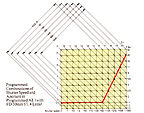 |
Programmed Combinations of Shutter Speed and Aperture in Programmed AE (with FD 50mm f/1.4 Lens) |
Download
a copy. Only available
in PDF format (219k) Fact remains, the T-50 is a very user
friendly camera. In fact, you don't have to be an expert to take perfect pictures
- even the very first time you handle it. Advanced electronics make it simple. Just
set the lens on "A" and the selector dial at "PROGRAM",
gently press the shutter button. That is all. The camera will measure the light,
concentrating on the center where the subject is usually positioned. Using this and
other data, it selects the most appropriate combination of shutter speed and lens
opening for the lighting conditions. That is how "Program" automation works
in camera. Of cause, the T50 is not an autofocus camera yet, you still need to turn
the focusing ring on the lens to make sure the subject snaps into focus.
Clear Symbols Tell the Story
The T50 with its built-in
winder is designed to respond instantly to a photographer's needs - without the hassle
of manually wind the film forward. The Programmed AE mode was designed and written
to lessen the risk of blurred pictures in low light, the T50 will choose the fastest
shutter speed the conditions will allow. (Referred to the EV chart above if you can
read and understand). In order to gather as much light as possible, the lens' widest
aperture is maintained at all speeds up to 1/60 sec. From that point, the shutter
speeds and f/numbers increase sharply.
When you are in program mode |
|
|
Blinks slowly as warning to use extra camera support or to use flash. Rapid blinking indicates flash is essential. |
||
The " |
||
Blinks when the aperture ring is not set on "A". |
Simple, Like the T50 Itself Programmed automation covers the flash photography as well. Canon has developed a new dedicated Speedlite that makes flash photography as easy as taking pictures in broad daylight. The fully automated 244T slips into the accessory shoe, linking up with the camera's own programmed microcomputer. It has just two switches:
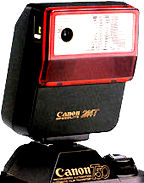 |
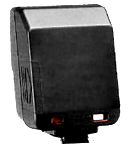 |
1) one to turn the unit on and off and 2) a film speed selector. The 244T will automatically sets the shutter speed to 1/60 sec. and when the shutter button is pressed halfway, it fires a low-intensity infrared pre-flash to judge the distance and reflectivity of the subject. It then sets one of three apertures for optimum results within the camerato-subject range, 0.5 to 5.7 meters (1.6 to 19 ft). |
Faster ISO/ASA 400 film will give
you perfectly exposed pictures up to 11.4m (37.6 fl) away or as close as 1m (3.3
ft). If the subject is too far away, the viewfinder's "P" mark will
blink in warning. A "![]() " lights up when the flash is charged and ready.
" lights up when the flash is charged and ready.
 |
 |
 |
Various
Canon |
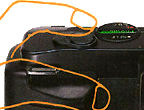 |
Shutter Release Button |
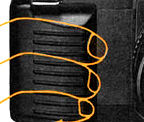 |
Firm Action Grip |
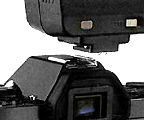 |
Accessory Shoe with Contacts |
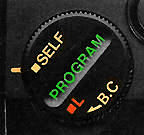 |
4-Positions Selector Dial The T50's "command center." The selector dial should be set to "PROGRAM" for normal photography and when using flash. |
Set the dial to "SELF" for 10 sec. self-timer operation. A beeping sound provides an audible reminder. The same audible signal confirms aufficient battery power when the dial is held at "BC." To prevent accidental shutter release, turn the dial to "L". This procedure is easy enough to understand, even without referring to the manual.
Film Speed Dial Any film speed from ISO/ASA 25 to 1600 can be set by pressing the an slightly oversized lock release button and rotating the dial.
 |
Since the T50 was not incorporated with AUTO DX film coding, you will still require to set the film speed manually. Well, there are some advantages because, you can use the film speed setting to over-ride and do exposure compensation if you require increased or decreased exposure values than what the camera has set. |
Comfortable Eyecup with Optional Diopters The large, molded rubber Eyocup T slides onto the eyepiece grooves and is air cushioned for more comfort.
 |
There is no built in dioptric correction for this camera, thus, you have to set them by changing the lenses. Ten eyesight correction lenses are available for dioptric correction between - 4 and + 3. |
| Previous | Next | 2/3 More...
Page One | Page Two | Page Three | Page Four | Page Five | Page Six
Specification & Main Reference Map: HTML | PDF (126k) |
| Message Board |
for your Canon
T-Series SLR camera(s)
| Message Board | for your Canon optics
in a shared environment
| Message Board | Specifically for Dispose or Looking for Canon Photographic
Equipment
|
Back | The Main Index page of
Canon T50
| Back |
Main Index Page of Canon A & T Series SLR camera Models
FL | Canon FDn lenses. | Early versions of FD lenses
Canon EOS SLRs | Canon EF lens Resources
Shared
Resources (some links are from Christain
Rollinger
site): Canon Command Back for T-series Models Instruction Manual; Canon Remote Switch 60 Manual Speedlites (Canon Flash models:-
Canon 300TL flash(1.5MB); Macrolite ML-1(HTML); Macrolite ML-2;
Macrolite ML-3; Speedlite 133a; Speedlite 155a(HTML); Speedlite 177a; Speedlite 188a(HTML); Speedlite 199a; Speedlite 244t; Speedlite 277t (HTML); Speedlite
533; Speedlite 577) & Macro photography.Others:- Canon Auto Bellow Unit Manual; Canon Macro Photography Guide, Canon Slide Duplicator Manual, Canon Angle Finder User's Manual
Canon FD
Resources
A Series:
AE-1
| AT-1
| A-1 | AV-1
| AE-1 Program | AL-1
T- Series: T50
| T60
| T70
| T80
| T90
F-1
| New F-1
Canon FL
Resources
Pellix
| FTQL
Home - Photography in Malaysia |
Copyright © 2000. leofoo ®. MIR Web Development Team.
Canon T series SLR camera MB Maintenance Team: Winston Lowe; Kaipin, Terry Carraway, John & Dr Strangelove; Pawel Nabe for his image on the Data Memory Back. EEwyn Foo, my nephew, who has spent quite a number of nights converting the original manual in HTML format. Mr. Richard Yeow and Mr Simon, heads of camera division at Canon Marketing, Malaysia for granting special permission to reproduce this manual into HTML format in his site as a form of obligation to all Canon FD mount users worldwide. * Canon, FD Lenses, Canon Marketing are registered trade names or trademarks of Canon Inc. Japan.